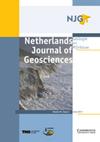An enigmatic lower jaw from the Lower Muschelkalk (Anisian, Middle Triassic) of Winterswijk provides insights into dental configuration, tooth replacement and histology
IF 2.3
2区 地球科学
Q3 GEOSCIENCES, MULTIDISCIPLINARY
Netherlands Journal of Geosciences-Geologie En Mijnbouw
Pub Date : 2021-10-18
DOI:10.1017/njg.2021.12
引用次数: 1
Abstract
Abstract In the aftermath of the Permo-Triassic mass extinction event, several reptile lineages radiated to form major components of marine faunas during the entire Mesozoic. The Lower Muschelkalk, which was deposited within a shallow inland sea in the Germanic Basin during the Middle Triassic, is one of the most important regions for understanding the early evolution of Mesozoic marine reptiles. Here, we present a new specimen from the Lower Muschelkalk of Winterswijk in the Netherlands, comprising an isolated left dentary that is morphologically distinct from any well-known Triassic vertebrate. We provide a detailed description of the jaw and the teeth using histological and micro-computed tomographic analyses. The anterior teeth are fang-like and curved, whereas the posterior teeth are wider and triangular-shaped. Tooth implantation is thecodont and teeth are ankylosed to the base of the alveolus. Replacement teeth are developed directly lingual to the functional teeth, starting with the formation of a resorption cavity on the dorsal surface of the alveolar margin. The replacement pattern cannot be observed in detail but is regular in the posterior part of the dentary with each tooth being alternated with an empty alveolus. The specimen can likely be assigned to Eosauropterygia based on its jaw morphology and dental morphology and replacement pattern, and it is remarkably similar to maxillae referred to the enigmatic Lamprosauroides goepperti from the Lower Muschelkalk of Poland. The dentary from Winterswijk lacks enlarged, ‘alveolarised’ crypts and corresponding distinct dental lamina foramina (DLFs) for the replacement teeth, a configuration that is typical of Sauropterygia, but which was likely not omnipresent in this clade. The specimen also exhibits loosely folded plicidentine at the roots of the teeth, likely representing the first identification of this feature in Sauropterygia.来自Winterswijk的lower Muschelkalk (Anisian,中三叠世)的一个神秘的下颌提供了对牙齿结构,牙齿替换和组织学的见解
在二叠纪-三叠纪大灭绝事件之后,几个爬行动物谱系在整个中生代期间辐射形成了海洋动物群的主要组成部分。下Muschelkalk沉积于中三叠世日耳曼盆地的浅海内,是了解中生代海洋爬行动物早期演化的重要区域之一。在这里,我们展示了一个来自荷兰Winterswijk的Lower Muschelkalk的新标本,包括一个孤立的左齿状动物,在形态上与任何已知的三叠纪脊椎动物都不同。我们提供了一个详细的描述颌骨和牙齿使用组织学和显微计算机断层扫描分析。前牙呈尖牙状弯曲,而后牙较宽,呈三角形。种植牙是齿状突,牙齿与牙槽底部紧密相连。替代牙直接发育到功能牙的舌侧,首先在牙槽缘的背表面形成一个吸收腔。替换模式不能详细观察,但在牙齿后部有规律,每颗牙齿交替有一个空的牙槽。根据其颌骨形态、牙齿形态和替换模式,该标本可能被归为eosaurpterygia,并且它与来自波兰下Muschelkalk的神秘Lamprosauroides goepperti的上颌骨非常相似。来自Winterswijk的牙齿缺乏扩大的“牙槽状”隐窝和相应的独特的牙板孔(DLFs)来替代牙齿,这种结构是典型的蜥脚类,但在这个进化支中可能并不普遍。该标本还在牙齿根部显示出松散折叠的上尖,可能代表了在蜥脚类动物中首次发现的这一特征。
本文章由计算机程序翻译,如有差异,请以英文原文为准。
求助全文
约1分钟内获得全文
求助全文
来源期刊
CiteScore
4.00
自引率
25.90%
发文量
14
审稿时长
>12 weeks
期刊介绍:
Netherlands Journal of Geosciences - Geologie en Mijnbouw is a fully open access journal which publishes papers on all aspects of geoscience, providing they are of international interest and quality. As the official publication of the ''Netherlands Journal of Geosciences'' Foundation the journal publishes new and significant research in geosciences with a regional focus on the Netherlands, the North Sea region and relevant adjacent areas. A wide range of topics within the geosciences are covered in the journal, including "geology, physical geography, geophyics, (geo-)archeology, paleontology, hydro(geo)logy, hydrocarbon exploration, modelling and visualisation."
The journal is a continuation of Geologie and Mijnbouw (published by the Royal Geological and Mining Society of the Netherlands, KNGMG) and Mededelingen Nederlands Instituut voor Toegepaste Geowetenschappen (published by TNO Geological Survey of the Netherlands). The journal is published in full colour.

 求助内容:
求助内容: 应助结果提醒方式:
应助结果提醒方式:


